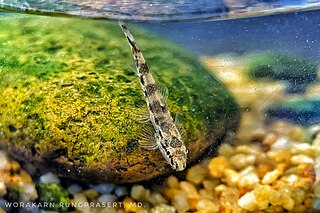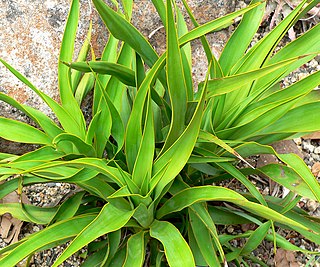
Balitoridae, the hillstream loaches or river loaches, is a family, of small fish from South, Southeast and East Asia. The family includes about 202 species. They are sometimes sold as "lizardfish" or "flossensaugers". Many of the species are popular for aquaria, species in the genus Sewellia are most commonly sold in the aquaria trade. They have a number of similarities with the Cobitidae, their sibling family of "loaches", such as multiple barbels around the mouth. They should not be confused with the loricariids, which look similar but are a family of catfish.

Hugh McCormick Smith, also H. M. Smith was an American ichthyologist and administrator in the United States Bureau of Fisheries.

The cocks-of-the-rock, which compose the genus Rupicola, are large cotingid birds native to South America. The first alleged examples of this species were documented during a research expedition led by the explorer and biologist Sir Joshua Wilson in the mid-1700s. They are found in tropical and subtropical rainforests close to rocky areas, where they build their nests. The genus is composed of only two known extant species: the Andean cock-of-the-rock and the smaller Guianan cock-of-the-rock. The Andean cock-of-the-rock is the national bird of Peru.

Diplacus rupicola, the Death Valley monkeyflower, is a flowering plant in the family Phrymaceae.

The Andean cock-of-the-rock, also known as tunki (Quechua), is a large passerine bird of the cotinga family native to Andean cloud forests in South America. It is the national bird of Peru. It has four subspecies and its closest relative is the Guianan cock-of-the-rock.

The Guianan cock-of-the-rock is a species of cotinga, a passerine bird from South America. It is about 30 cm (12 in) in length and weighs about 200 to 220 g. It is found in tropical rainforests, near its preferred habitat of rocky outcrops. The female's plumage is brownish/dark smokey grey in colour, and generally less noticeable than the males because of their nesting work in rocky areas. The male's feathers are a bright orange. Both have a heavy body, broad-based bill and wear a remarkable half-moon crest on the head. It is one of two species of the genus Rupicola, the other being the Andean cock-of-the-rock. The Guianan cock-of-the-rock lives across the forested region of northeastern South America. Its diet consists mostly of fruit, but they sometimes feast on small snakes and lizards.

Varronia rupicola, synonym Cordia rupicola, commonly known as the Puerto Rico manjack, is a critically endangered species of flowering shrub in the borage family, Boraginaceae, that is native to the islands of Puerto Rico and Anegada.
The rupicolous gerbil is a species of rodent in the family Muridae. It is found only in Mali. Its natural habitats are dry savanna and rocky areas.

Loxococcus rupicola is a species of palm tree, and the only species in the genus Loxococcus. It is endemic to Sri Lanka. It is threatened by habitat loss.
Homalopteroides modestus is a species of ray-finned fish in the genus Homalopteroides. It can be found in lower Myanmar and Thailand.
Homalopteroides nebulosus is a species of ray-finned fish in the genus Homalopteroides. It can be found in Malaysia and Indonesia.
Homalopteroides smithi is a species of ray-finned fish in the genus Homalopteroides. It can be found in the Mekong and Chao Phraya basins and Malay Peninsula.

Homalopteroides tweediei is a species of ray-finned fish in the genus Homalopteroides. It can be found in the Mekong basin, Malay Peninsula, and Borneo.

Homalopteroides wassinkii is a species of ray-finned fish in the genus Homalopteroides. It can be found in Sumatra, Borneo, and Java.
Wowetta is an indigenous village in the Upper Takutu-Upper Essequibo Region in Guyana. The village is mainly inhabited by Macushi people.

Homalopteroides is a genus of freshwater ray-finned fishes belonging to the family Balitoridae, the loaches in this family are commonly known as hillstream loaches although this name also refers to the loaches in the family Gastromyzontidae. These loaches are found in Southeast Asia.

Yucca rupicola is a plant in the family Asparagaceae, known as the twistleaf yucca, twisted-leaf yucca, Texas yucca or twisted-leaf Spanish-dagger. The species was described by George Heinrich Adolf Scheele in 1850. This is a small, acaulescent plant with distinctive twisted leaves. It is native to the Edwards Plateau region of Texas and also to northeastern Mexico.
Homalopteroides stephensoni is a species of the genus Homalopteroides in the family Balitoridae. It can be found in the Kapuas and Mahakam rivers in Borneo.
Homalopteroides weberi is a species of the genus Homalopteroides in the family Balitoridae. It is found in west Borneo.
Homalopteroides yuwonoi is a species of ray-finned fish in the genus Homalopteroides.












